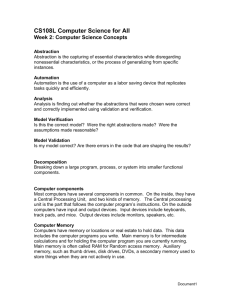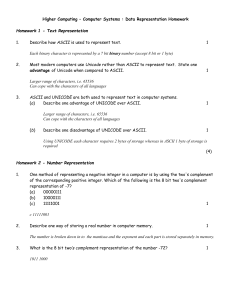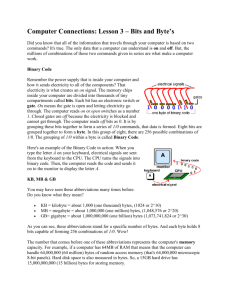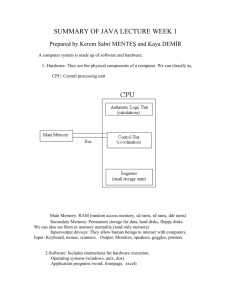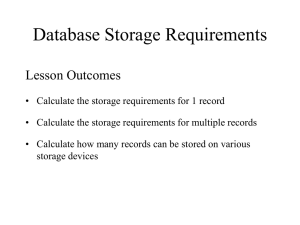suppose decimal
advertisement
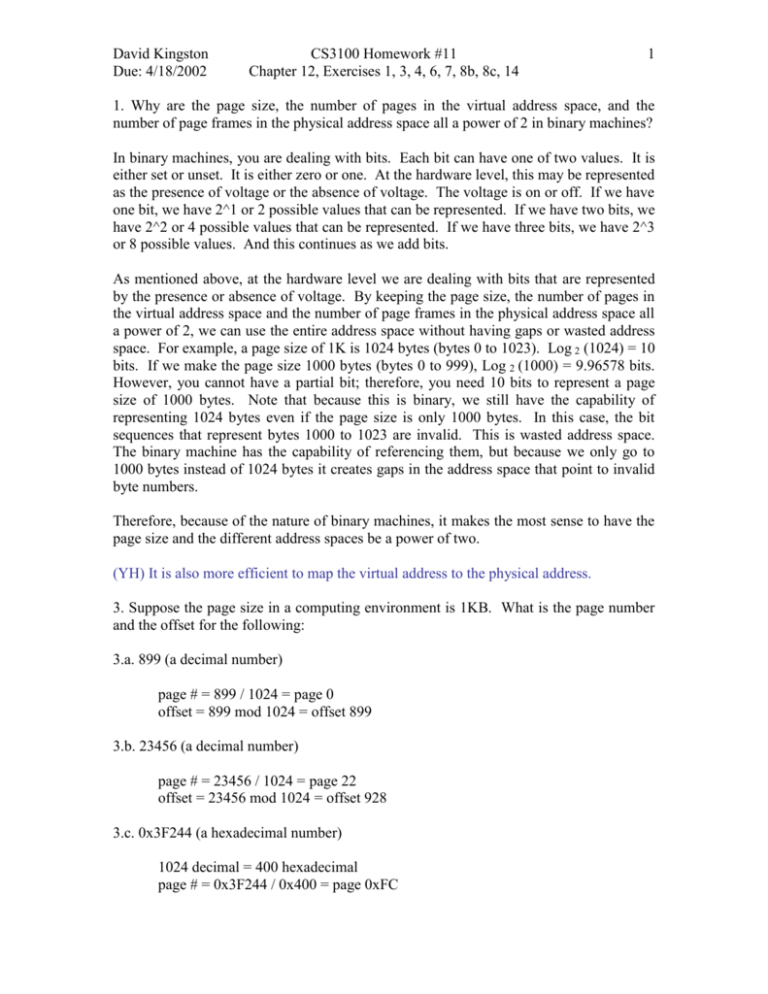
David Kingston Due: 4/18/2002 CS3100 Homework #11 Chapter 12, Exercises 1, 3, 4, 6, 7, 8b, 8c, 14 1 1. Why are the page size, the number of pages in the virtual address space, and the number of page frames in the physical address space all a power of 2 in binary machines? In binary machines, you are dealing with bits. Each bit can have one of two values. It is either set or unset. It is either zero or one. At the hardware level, this may be represented as the presence of voltage or the absence of voltage. The voltage is on or off. If we have one bit, we have 2^1 or 2 possible values that can be represented. If we have two bits, we have 2^2 or 4 possible values that can be represented. If we have three bits, we have 2^3 or 8 possible values. And this continues as we add bits. As mentioned above, at the hardware level we are dealing with bits that are represented by the presence or absence of voltage. By keeping the page size, the number of pages in the virtual address space and the number of page frames in the physical address space all a power of 2, we can use the entire address space without having gaps or wasted address space. For example, a page size of 1K is 1024 bytes (bytes 0 to 1023). Log 2 (1024) = 10 bits. If we make the page size 1000 bytes (bytes 0 to 999), Log 2 (1000) = 9.96578 bits. However, you cannot have a partial bit; therefore, you need 10 bits to represent a page size of 1000 bytes. Note that because this is binary, we still have the capability of representing 1024 bytes even if the page size is only 1000 bytes. In this case, the bit sequences that represent bytes 1000 to 1023 are invalid. This is wasted address space. The binary machine has the capability of referencing them, but because we only go to 1000 bytes instead of 1024 bytes it creates gaps in the address space that point to invalid byte numbers. Therefore, because of the nature of binary machines, it makes the most sense to have the page size and the different address spaces be a power of two. (YH) It is also more efficient to map the virtual address to the physical address. 3. Suppose the page size in a computing environment is 1KB. What is the page number and the offset for the following: 3.a. 899 (a decimal number) page # = 899 / 1024 = page 0 offset = 899 mod 1024 = offset 899 3.b. 23456 (a decimal number) page # = 23456 / 1024 = page 22 offset = 23456 mod 1024 = offset 928 3.c. 0x3F244 (a hexadecimal number) 1024 decimal = 400 hexadecimal page # = 0x3F244 / 0x400 = page 0xFC David Kingston Due: 4/18/2002 CS3100 Homework #11 Chapter 12, Exercises 1, 3, 4, 6, 7, 8b, 8c, 14 2 offset = 0x3F244 mod 0x400 = offset 0x244 3.d. 0x0017C (a hexadecimal number) 1024 decimal = 400 hexadecimal page # = 0x0017C / 0x400 = page 0 offset = 0x0017C mod 0x400 = offset 0x17C 4. Contemporary computers often have more than 100MB of physical memory. Suppose the page size is 2KB. How many entries would an associative memory need in order to implement a page table for the memory? 100 x 1024 x 1024 / (2 x 1024) = 51200 pages = 50 K pages We need 50 K entries in the table (1 for each page). 6. What factors could influence the size of the virtual address space in a modern computer system? In your answer consider the memory mapping unit, compiler technology, and instruction format. To answer this question, we must consider the following information. A program address is relative to the program and start at address 0. The CPU relocation register contains the starting virtual address of where the program is located in virtual memory. The program address is added to the relocation register contents to get the virtual address of the instruction being executed. This is sent to the Memory Management Unit (MMU). The MMU divides the virtual address up into two parts. The higher bits represent the memory page. The lower bits represent the offset on the page. The higher bits of the virtual address are looked up in the page translation table in the MMU to determine the physical memory page. The offset is then added to the physical memory address to get the physical memory address of the instruction being executed. Having given the above short analysis of what is taking place; I believe the most important factor in determining the virtual address space of a modern computer system is the hardware architecture of the computer. This includes considering the size in bits of the CPU registers, the communication channel between the CPU and the MMU, the CPU instruction addresses, etc. The hardware architecture determines the maximum address that the computer is capable of handling. For example, if the computer is a 32 bit computer it can handle a virtual address space of 2^32 (or 4GB). If the computer architecture is 64 bits, it can handle a virtual address space of 2^64 (or 17,179,869,184 GB). The MMU then maps the virtual address to the physical address. As far as compiler technology is concerned, it will assume that the program addresses start at zero and that programs have the entire virtual address space available to them. I believe the compiler would mainly be concerned about not hitting the upper limit of the address space. David Kingston Due: 4/18/2002 CS3100 Homework #11 Chapter 12, Exercises 1, 3, 4, 6, 7, 8b, 8c, 14 3 (YH) Instruction format works with instruction registers. Instructions such as load and save may have different format for different virtual address space. Other factors that determine the virtual address space include cost and complexity of the architecture. 7. What factors could influence the size of the physical address space in a modern computer system (consider various parts of the hardware). The computer architecture determines the maximum physical address space. For example, a 32 bit architecture can have up to 2^32 bytes (or 4GB) of physical address space. This is assuming the MMU is capable of handling a physical address space equal to the virtual address space. (Note that when the physical address space is equal to the virtual address space, there is no need for the virtual address space to be different than the physical address space.) The computer chip technology determines how many bits a single chip can hold. The physical size of the memory card determines the number of chips a single card can hold. The number of memory slots available determines the number of memory cards the computer can hold. All of these things influence the size of the physical address space in a modern computer system. Other considerations include cost and complexity. 8. Suppose w = 2 3 4 3 2 4 3 2 4 5 6 7 5 6 7 4 5 6 7 2 1 is a page reference stream. 8.b. Given a page frame allocation of 3 and assuming the primary memory is initially unloaded, how many page faults will the given reference stream incur under LRU (leased recently used)? Frame 2 3 4 3 0 *2 2 2 2 1 *3 3 3 2 *4 4 2 2 3 4 4 2 3 4 3 2 3 4 2 2 3 4 4 2 3 4 5 2 *5 4 6 *6 5 4 7 6 5 *7 5 6 5 7 6 6 5 7 7 6 5 7 4 6 *4 7 5 *5 4 7 6 5 4 *6 7 5 *7 6 2 *2 7 6 1 2 7 *1 This will have 12 page faults. 8.c. Given a page frame allocation of 3 and assuming the primary memory is initially unloaded, how many page faults will the given reference stream incur under FIFO (firstin-first-out)? Frame 2 3 4 3 0 *2 2 2 2 1 *3 3 3 2 *4 4 2 2 3 4 4 2 3 4 3 2 3 4 This will have 12 page faults. 2 2 3 4 4 2 3 4 5 *5 3 4 6 5 *6 4 7 5 6 *7 5 5 6 7 6 5 6 7 7 5 6 7 4 *4 6 7 5 4 *5 7 6 4 5 *6 7 *7 5 6 2 7 *2 6 1 7 2 *1 David Kingston Due: 4/18/2002 CS3100 Homework #11 Chapter 12, Exercises 1, 3, 4, 6, 7, 8b, 8c, 14 4 14. In a paging system, page boundaries are transparent to the programmer. Explain how a loop might cause thrashing in a static allocation paging system when the memory allocation is too small. A static paging algorithm allocates a fixed number of page frames to a process when it is created. It is possible for a loop to contain instructions that require the program to get a new page of instructions multiple times in a loop. For example, there may be function calls in the loop that are located in different memory pages. To execute these functions, the required text pages must be moved into primary memory. If the memory allocation is too small, it is conceivable that each function call could require moving a different page into primary memory from virtual memory. As the loop starts again, the page with the first function called could have been paged out. It must be paged in again. This could continue with each iteration of the loop. This is one example of how a loop might result in thrashing if the memory allocation is too small.
